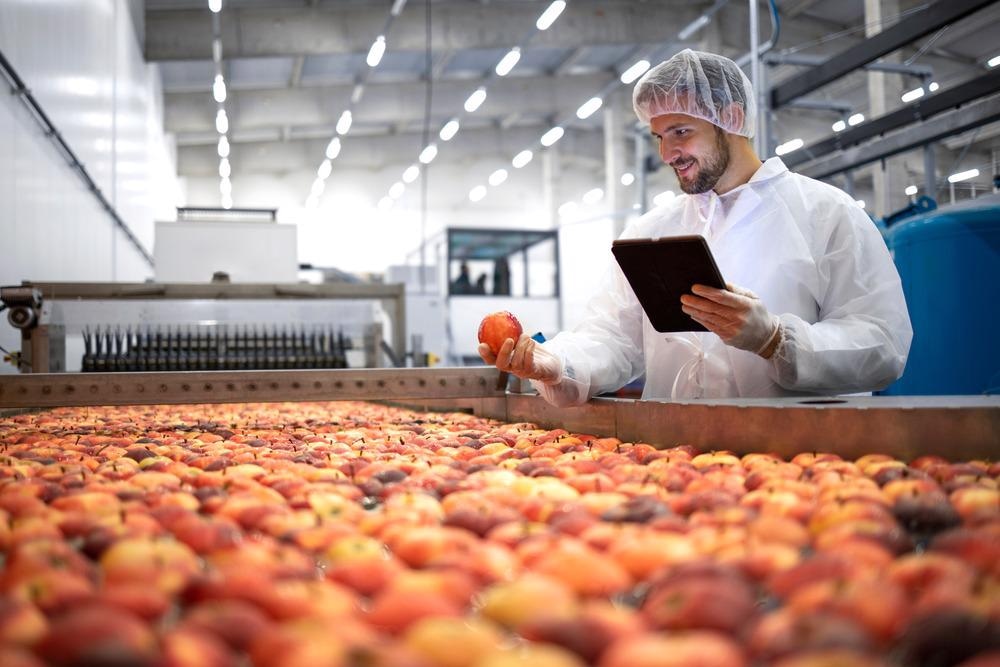The food automation market is predicted to grow to $29.4 billion by 2027. This growth is due to various factors, not least the complementary challenges of rising populations, inflation, dwindling crop yields, and the climate emergency. Automation in food analysis is growing for similar reasons, but it will also see growth due to increased food safety regulations and improving technology.

Image Credit: Aleksandar Malivuk/Shutterstock.com
Automation in the food industry uses advanced technologies like robotics, smart devices, Internet of Things (IoT) connectivity, artificial intelligence (AI,) analytics, mobility, data processing, and 3D printing to make food processing more productive and efficient. Advanced automation and intelligent production improve shelf-life, food safety, consumer satisfaction, and business growth.
Food analysis is a key part of all food production from the global corporate scale down to the scale of small, local cottage industries. In the modern, automated food processing sector, food analysis must be automated as well. Robust, efficient, sensitive, and cost-effective methodologies are a key research focus for academia and industrial R&D departments alike.
The purpose of food analysis is to assure producers and consumers that the food that is coming out of factories is safe, of a high quality and has traceable ingredients that match the description on the label and comply with legislation.
Today, old “wet chemistry” methods from the early 20th century have been replaced by powerful instrumental techniques in food laboratories – powered with automation. As a result, the analytical accuracy, detection limits, precision, and sample throughput capacity have all improved considerably. This has expanded the range of practical applications for food analysis and in part drives growth in the food automation market.
The food automation market also drives and enables growth in the global food infrastructure system. Modern globalized food distribution relies heavily on food analysis for food production, product development, quality control and analysis, and regulatory compliance.
Automation in Food Analysis: A Growing Market
The Robotics Industries Association and Association for Advancing Automation recently produced a joint market research report that found that food and consumer goods manufacturers ordered a significantly higher number of automation systems in 2020 – 56%.
This growth is predicted to continue for the next five years at least, say market analysts Meticulous Research. In a market research report published in January 2022, the firm forecasted a compound annual growth rate (CAGR) for the food automation market of 9.5% between 2020 and 2027. This would see the market reaching a total value of $29.4 billion by 2027.
Analysts attributed this growth to the now widespread adoption rates for automation in the food processing sector. Plant- and enterprise-level control solutions are now available that can automate entire parts of the food process from production to quality control and analysis, transportation, distribution, and customer relations. This makes the whole process of getting food into consumers’ shopping carts more efficient.
In the case of food analysis, the rising demand for automation solutions is fuelled in part by changing purchasing patterns. Consumers now want more quality, more accurate labeling, and better safety guarantees from their food than ever before.
Despite the relatively large upfront costs for automation technologies and equipment, investment is typically returned through increased productivity and customer satisfaction in the medium to long term.
Enabling Technologies: Focus on Artificial Intelligence
The food automation market relies on enabling several technologies to work, just like all industrial automation. Digital instrumentation and sensors are needed to translate physical information into data that can be processed in computers. Advanced engineering and robotics create physical machines that interact with food samples, sometimes even on the nanoscale.
AI is another key enabling technology for industrial automation, and food analysis automation is no exception. AI applies instructions for computers (algorithms) to make computers act in an “intelligent” way, for example, by learning from data and adjusting behaviors (machine learning.)
Machine vision programs are some of the most common applications of AI in automated food analysis. These are often packaged in with other food process automation systems. They use image or video data to scan items on the production line and reject defective produce.
Increasing Food Safety Regulations to Drive the Growth of the Food Automation Market
As well as providing quality control, the food automation market also helps producers comply with food safety regulations. This is increasingly important in a globalized food system, as problems in one facility can have knock-on effects worldwide.
The World Health Organization estimates that 600 million people get sick after eating contaminated food each year. The US Center for Disease Control and Prevention estimates that 70% of all diseases in food are caused by viruses spread by infected people coming into contact with food.
Automation enables producers to analyze and control more food without reducing production throughput rates. With an increasingly connected and globalized food system – and the potential for diseases to halt the world’s entire economy – food analysis will require automation to keep our food supply safe.
From Farm to Fork: Cutting Down on Food Waste with Machine Learning
Reference and Further Reading
Chand, S. (2021). AI in the Food and Beverage Industry – 3 Current Use-Cases. Emerj.com. [Online] Available at: https://emerj.com/ai-sector-overviews/artificial-intelligence-food-beverage/.
Cifuentes, A. (2012). Food Analysis: Present, Future, and Foodomics. International Scholarly Research Notices. Available at: https://doi.org/10.5402/2012/801607.
Meticulous Market Research (2022). Food Automation Market Worth $29.4 Billion by 2027 - Market Size, Share, Forecasts, & Trends Analysis Report with COVID-19 Impact. Globalnewswire.com. [Online] Available at: https://www.globenewswire.com/news-release/2022/01/24/2371821/0/en/Food-Automation-Market-Worth-29-4-Billion-by-2027-Market-Size-Share-Forecasts-Trends-Analysis-Report-with-COVID-19-Impact-by-Meticulous-Research.html.
Disclaimer: The views expressed here are those of the author expressed in their private capacity and do not necessarily represent the views of AZoM.com Limited T/A AZoNetwork the owner and operator of this website. This disclaimer forms part of the Terms and conditions of use of this website.